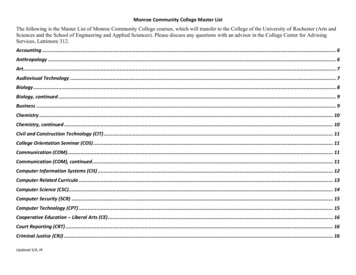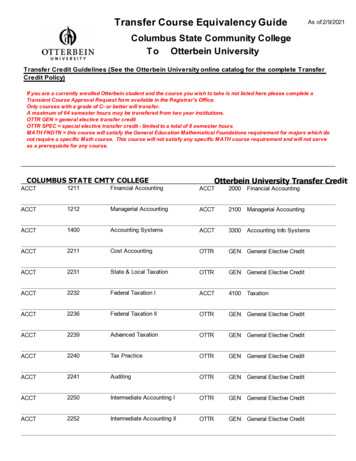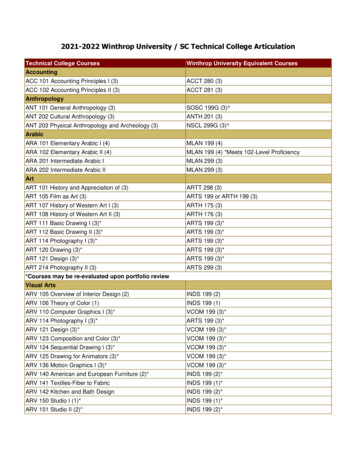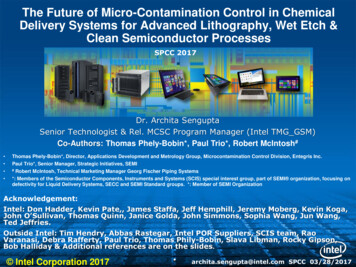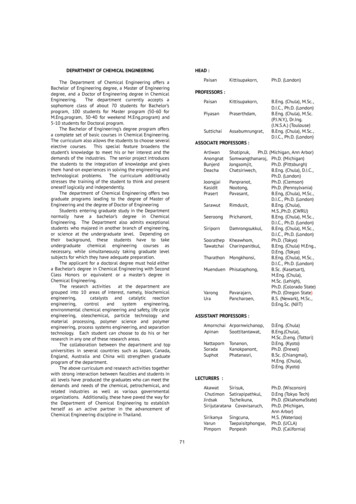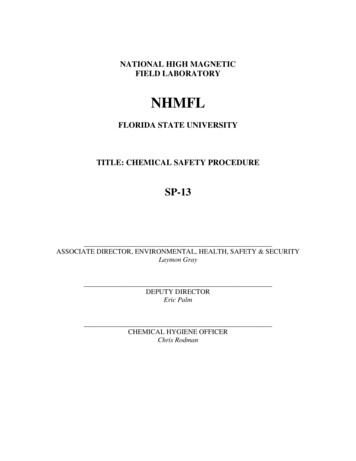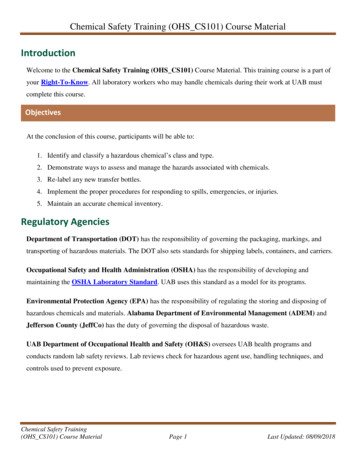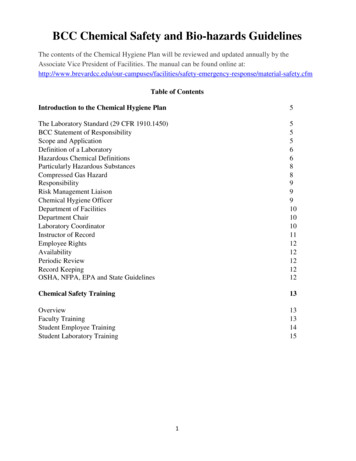
Transcription
BCC Chemical Safety and Bio-hazards GuidelinesThe contents of the Chemical Hygiene Plan will be reviewed and updated annually by theAssociate Vice President of Facilities. The manual can be found online le of ContentsIntroduction to the Chemical Hygiene Plan5The Laboratory Standard (29 CFR 1910.1450)BCC Statement of ResponsibilityScope and ApplicationDefinition of a LaboratoryHazardous Chemical DefinitionsParticularly Hazardous SubstancesCompressed Gas HazardResponsibilityRisk Management LiaisonChemical Hygiene OfficerDepartment of FacilitiesDepartment ChairLaboratory CoordinatorInstructor of RecordEmployee RightsAvailabilityPeriodic ReviewRecord KeepingOSHA, NFPA, EPA and State Guidelines5556688999101010111212121212Chemical Safety Training13OverviewFaculty TrainingStudent Employee TrainingStudent Laboratory Training131314151
General Standard Operating ProceduresGeneral Safety PrinciplesHealth and HygieneFood and Drink in the LaboratoryHousekeeping PracticesChemical Handling and StorageTransporting of ChemicalsUnattended OperationsWorking AlonePrior ApprovalStandard Repair/Transfer/Close-Out/ Transportation Procedures1717182020212121222222Laboratory Management Plan for Waste HandlingGeneral IntroductionChemical Waste Handling in Academic SpacesChemical Hygiene Officer’s ResponsibilityDefinitionsCollectionRemoval from LabsTime Limits on Storage in the Central Accumulation AreaTransportation and DisposalLaboratory Clean-OutsList of Dangerous Chemicals Used At Brevard Community CollegeTreatment Permitted On-SiteCollection and Disposal of Biomedical WastesCollection and Disposal of Controlled Substances2424242424252728282829293132Hazard Specific Standard Operating ProceduresHazard IdentificationChemicals Developed in the LaboratoryHealth HazardsPhysical Hazards3434343537Substance Specific Standard Operating Procedures41Emergency/Medical ProceduresBasic Steps for Emergency and Spill ResponseInjury and Illness4242422
Standard Laboratory Facility RequirementsSigns and InformationVentilation ControlsHandling Compressed GasSpill KitsPersonal Protective EquipmentInventory ControlRemoval of Empty ContainersAnnual Chemical Inventory464649505252535454Glossary553
AppendicesPhysical Properties and Reactivity ListsAppendix 1Appendix 1A60Appendix 1EAppendix 1FChemical Compatibility ChartsFlammable Chemical Guidelines & InformationCommon Laboratory Flammable and CombustibleChemicalsFlammable and Combustible Liquid Containment andStorage RequirementsCommon Laboratory CorrosivesCommon Laboratory OxidizersPeroxidizable Chemical Guidelines & InformationIntroductionClasses of Peroxidizable ChemicalsTesting Guidelines for Peroxide-FormersShock Sensitive and Explosive ChemicalsList of l Injury / Exposure ReportLaboratory Safety Training CertificateMaterial Safety Data Sheet Request FormEquipment Release FormAppendix 1BAppendix 1CAppendix 1DForms7522A2B2CInformation for Waste Handling77Appendix 3Waste Accumulation RecordAppendix 3AEPA P-List (Acute Hazardous Substances List)Appendix 3BEPA U-List (Hazardous Substances List)Appendix 3CBrevard Community College Biomedical Waste PlanMiscellaneousAppendix 4Appendix 4AAppendix 4B97Site Specific Training ChecklistGlove Selection ChartSubstance-Specific Standard Operating ProceduresWorksheet Page 74
I.INTRODUCTIONThe Laboratory StandardThe Department of Labor published in the Federal Register an amendment to 29 CFR 1910,http://www.osha.gov/pls/oshaweb/owadisp.show document?p table STANDARDS&p id 10106Subpart Z (Toxic and Hazardous Substances), identified as Section 1910.1450. The title of theamendment is Occupational Exposure to Hazardous Chemicals in the Laboratory, better known asthe Laboratory Standard or Lab Standard.The Laboratory Standard is intended to ensure that employees who work in a laboratory settingwill be protected from any chemical exposures that exceed permissible exposure limits and thatemployees will be educated as to the hazardous nature of the chemicals they use in the laboratory.The Laboratory Standard requires the College to appoint a Chemical Hygiene Officer (CHO) whowill provide expertise to develop, implement, and monitor the required Chemical Hygiene Plan(CHP) in consultation with faculty and other employees. The policies set forth in the CHP must becapable of (1) protecting employees and students from health hazards associated with hazardouschemicals in that laboratory and (2) keeping exposures below the Lab Standard’s specified limits.BCC Statement of ResponsibilityBrevard Community College (BCC) will provide a safe and healthful environment, free fromrecognized hazards that may cause serious injury to students, employees, and visitors. This isaccomplished by maintaining a comprehensive safety, health, and environmental program thatinvolves all college employees. BCC will conduct all of its activities in compliance with applicablestandards, codes, regulations, and laws. Every person at the institution understands that safety andhealth is an integral part of every task.With respect to the Laboratory Standard, it is BCC’s policy to fully comply with all applicable lawand regulations. BCC hereby institutes this Chemical Hygiene Plan as a component of its safetyprogram.Scope and ApplicationThis document serves as the written guidance for BCC to comply with the Laboratory Standard.All employees at BCC engaged in the laboratory use of hazardous chemicals are required tocomply with this document.The objective of this document is to provide guidance for the safe handling of hazardous chemicalsin laboratories. The Chemical Hygiene Plan establishes the basic safety principles for laboratoryprocedures, equipment and work practices to protect employees and students from exposure tohazardous chemicals in laboratories. This document is intended to highlight those safety measuresnecessary for achieving a safe and a healthy work and learning environment. Where the scope of ahazard is not adequately addressed by this general document, the Laboratory Supervisor mustdevelop specific standard operating procedures.This document will hereafter be known as the BCC Chemical Hygiene Plan or BCCCHP.5
Definition of a LaboratoryThis section identifies facilities within the College that are to be considered a laboratory as definedby OSHA. Activities within these facilities must comply with the Laboratory Standard. Otherfacilities that use or store hazardous materials, and/or use hazardous chemicals that do not meet thedefinition of laboratory use, must comply with other applicable OSHA standards, including theHazard Communication Standard and the substance specific standards of 29 CFR sp.show document?p table STANDARDS&p id 10106#1910.1450(b)Laboratory use of hazardous chemicals means handling or use of such chemicals in which all ofthe following conditions are met:A. Chemical manipulations are carried out on a laboratory scale;B. Multiple chemical procedures or chemicals are used;C. The procedures involved are not part of a production process, nor in any way simulate aproduction process; andD. Protective laboratory practices and equipment are available and in common use tominimize the potential for employee exposure to hazardous chemicals.Laboratory scale means work with substances in which the containers used for reactions, transfers,and other handling of substances are designed to be easily and safely manipulated by one person.Laboratory scale excludes those workplaces whose function is to produce commercial quantities ofmaterials.Protective laboratory practices and equipment means those laboratory procedures, practice andequipment accepted by laboratory health and safety experts as effective, or that the employer canshow to be effective, in minimizing the potential for employee exposure to hazardous chemicals.Hazardous Chemical DefinitionsInstructors of Record and other personnel are responsible for correctly identifying all applicablehazards in their lab(s) and communicating those hazards to all workers, visitors, and students in thelab.The Lab Standard defines hazardous chemicals as a chemical for which there is statisticallysignificant evidence based on at least one study conducted in accordance with established scientificprinciples that acute or chronic health effects may occur in exposed employees and students. Whilethe Lab Standard is intended to focus on health effects of chemicals, it and other standards andregulations govern the safe handling of more broadly defined hazardous materials. To meet theseexpanding health and safety requirements, criteria are presented here for identifying materials thatare both health hazards and physical hazards.Health hazards include chemicals that are carcinogens, toxic or highly toxic agents, reproductivetoxins, irritants, corrosives, sensitizers, hepatotoxins, nephrotoxins, neurotoxins, agents that act onthe hematopoietic systems, and agents that damage the lungs, skin, eyes, or mucous membranes.6
Physical hazards includes chemicals for which there is scientifically valid evidence that they arecombustible liquids, a compressed gas, explosive, flammable, an organic peroxide, an oxidizer,pyrophoric, unstable (reactive) or water reactive.Toxic Hazard CriteriaA substance will be considered to present a toxic hazard requiring the use of procedures for toxicchemicals when any one of the following criteria is met:The MSDS or container label identifies or describes the substance as toxic.The substance meets the definition of toxic in the Hazard Communication Standard 29CFR 1910.1200 Appendix A:http://www.osha.gov/pls/oshaweb/owadisp.show document?p table STANDARDS&p id 10100Any substance whose toxic properties are unknown.Fire Hazard CriteriaA substance will be considered to present a fire hazard requiring the use of procedures for firehazards when any one of the following criteria is met:The MSDS or container label identifies or describes the substance as flammable orcombustible.The substance fits the definition of combustible liquid in the OSHA LaboratoryStandard (29 CFR .show document?p table STANDARDS&p id 10106The substance fits any of the following definitions of flammable chemicals in theOSHA Laboratory Standard (29 CFR .show document?p table STANDARDS&p id 10106Reactivity Hazard CriteriaA substance will be considered to present a reactivity hazard requiring the use of procedures forreactive chemicals when any one of the following criteria is met:The MSDS or container label identifies or describes the substance as unstable, reactive,explosive, dangerous when wet, pyrophoric, an oxidizer, or organic peroxide.The substance fits the definition of unstable (reactive), explosive, organic peroxide,oxidizer, or water reactive in the OSHA Laboratory Standard (29 CFR .show document?p table STANDARDS&p id 10106The substance fits the definition of pyrophoric in the Hazard Communication Standard(29 CFR .show document?p table STANDARDS&p id 100997
Corrosively Hazard CriteriaA substance will be considered to present a corrosively hazard requiring the use of procedures forcorrosive chemicals when any one of the following criteria is met:The MSDS or container label identifies or describes the substance as corrosive.The substance fits the OSHA definition of corrosive in the Hazard CommunicationStandard (29 CFR show document?p table STANDARDS&p id 10099Contact Hazard CriteriaA substance will be considered to present a contact hazard requiring the use of procedures forcontact hazards when any one of the following criteria is met:The MSDS or container label identifies or describes the substance as an allergen,irritant, or sensitizer; orThe substance fits the OSHA definition of an irritant or sensitizer in the HazardCommunication Standard (29 CFR 1910.1200):Particularly Hazardous Substance CriteriaA substance will be considered a particularly hazardous substance requiring the use of proceduresfor particularly hazardous substances when any of the following criteria are met:The MSDS or container label identifies or describes the substance as a carcinogen,reproductive toxin, or highly toxic.The substance meets the definition of highly toxic in the Hazard CommunicationStandard (29 CFR .show document?p table STANDARDS&p id 10099The substance meets the definition of a select carcinogen in the Laboratory Standard(29 CFR .show document?p table STANDARDS&p id 10106Compressed Gas Hazard CriteriaA substance will be considered to present a compressed gas hazard requiring the use of proceduresfor compressed gases when any of the following criteria is met:The MSDS or container label identifies or describes the substance as a compressed gas;orThe substance meets the definition of a compressed gas in the Laboratory Standard (29CFR .show document?p table STANDARDS&p id 101068
ResponsibilityEmployees of the College are responsible for ensuring that they implement and follow theprocedures put forth in the BCC Chemical Hygiene Plan.Risk ManagerConduct periodic laboratory inspections to assure compliance with federal, state and localregulations, and the policies and procedures as defined by the College. Minimum annualinspection and maintain log for safety equipment inspections.Undertake necessary enforcement actions to assure full compliance with all institutionalsafety policies, up to and including independent authority to shut down laboratories forviolations of these policies.Provide hazardous material spill response services. The Emergency Response Team isavailable on campus during normal business hours and responds to after-hours spillemergencies on a call back basis.Reviews laboratory construction, modification and renovation plans for safety designcompliance.Coordinate fume hood inspections for safety compliance at least annually.Perform exposure monitoring upon request to determine if the permissible exposure limitor action level has been exceeded.Provide guidance for maintaining compliance with federal, state, and local regulations, aswell as the procedures stated in this manual.Conduct laboratory safety evaluations when requested by laboratory coordinators ordepartment chairs.Schedules and conducts fire drills and emergency and disaster drills.Regularly inspects and maintains fire extinguishers.Provides routine inspections of emergency equipment, including eyewashes, fireextinguishers, and emergency showers.Coordinates required tests for sprinklers, fire pumps, fire extinguishers and fire alarmsystem.Reviews “Accident/Incident” reports to determine trends.If authorized by the AVP of Facilities appoint and transfer appropriate enforcementauthority to a Chemical Hygiene Officer (CHO). The department chair assumes allresponsibilities of the CHO when there is not a specified CHO.The Chemical Hygiene OfficerAdvises on matters of material safety policies and practices and:Works with administrators and other employees to develop and implement the appropriatechemical hygiene policies and practices.Organizes, schedules and disposes of chemicals and hazardous waste.Assures that appropriate audits are conducted.Helps laboratory supervisors develop precautions and in consultation with the ProvostOffice develops adequate facilities.Knows the current legal requirements concerning regulated substances.9
Seeks ways to improve the chemical hygiene plan.Conducts information and general training sessions.Assists with the investigation of accidents involving hazardous materials.Provides necessary information to the healthcare professional when a report of possibleoverexposure occurs.Coordinates the testing of laboratory facilities, such as fume hoods, eye washes andemergency showers.Schedules services for hazardous waste disposal.Knows the location of safety resources, both in print and electronic form.Writes, or assists laboratory supervisors in writing standard operating procedures pertinentto their needs.Maintains the file of older material safety data sheets for hazardous materials used inCollege laboratories. Older is defined here as a document that cannot be located online onthe manufacturer’s website.The Office of Facilities is responsible for the overall management and operation of laboratorysafety and College safety programs.The Department Chair is responsible for compliance with the Chemical Hygiene Plan forlaboratories in his or her department and:Assures that action is taken to correct work practices and conditions that may result in therelease of hazardous materials.Implements the BCCCHP for those laboratories where the Instructor of Record does notexercise primary discretion in the choice of hazardous materials used or stored in theirlaboratories.The Laboratory Coordinators will:Conduct laboratory processes and operations to assure that employee and student exposureto risk conforms to the policies, and procedures as defined by the college.Monitor the procurement, safe use, and proper disposal of chemicals.Take all reasonable precautions to protect the safety and health of laboratory workers,students and the environment.Schedule services through the Risk Management Liaison for hazardous waste disposal andoversee the handling of hazardous waste pending proper disposal.Conduct regular laboratory safety self-evaluations.Complete and update annual laboratory chemical inventories in accord with the instructionsand schedule provided by the Office of Safety.Inform employees of the permissible exposure limits for the hazardous chemicals listed oninventories and the signs and symptoms associated with exposures to these chemicals.Provide site specific training to student assistants and volunteers on laboratory hazards asdescribed in The College's Hazard Communication Program.10
Obtain pre-approval from the Department Chair and provide training and documentationfor procedures, activities or operations.Maintain inventory of personal protective equipment, fire extinguishers, fume hoods,flammable liquid storage cabinets, biological safety cabinets, eye washes, safety showers,and spill cleanup kits. Assure that safety equipment is available and in working order andthat appropriate training for each item has been provided.Have readily available a current copy of a Material Safety Data Sheet for all hazardouschemicals in the laboratory.Post emergency telephone numbers by all telephones in the area.Report to Safety if there is reason to believe that exposure levels for a hazardous chemicalexceed the action level or the permissible exposure limits and document the incident.Forward documentation on laboratory accidents and exposures to The Department ofSafety.The Instructor of Record is the faculty or staff member under whose instruction hazardousmaterials are used and/or stored in the laboratory. The supervisor has a primary responsibility forimplementing the BCCCHP in the laboratory and:Assures that workers and students know and follow the chemical hygiene rules.Assures that all employees and students have completed all necessary training as outlinedby the BCCCHP.Assures that training specific to the laboratory’s procedures and chemicals has beenprovided.Assures that the required level of personal protective equipment is available, in workingorder, that training in its use has been provided, and that it is used when appropriate.Provides regular, formal chemical hygiene and housekeeping inspections.Knows the current legal requirements concerning regulated substances used in his/herlaboratory.Assures that facilities and training for use of any material being ordered is adequate to meetthe requirements of the BCCCHP.Provides for the safety of visitors in the laboratory.Prepares procedures for dealing with accidents that may result in the unexpected exposureof personnel or the environment to a hazardous material unless already outlined in theBCCCHP.Maintains the inventory of hazardous materials use under his or her supervision andprovide updated copies of the inventory to the Department of Safety.Assures that work areas where particularly hazardous substances or select carcinogens areused or stored are properly identified.Oversees the handling of laboratory waste, including hazardous material and chemicalwaste, clean-up of lab equipment, tables and glassware.11
Employee RightsIn accordance with the “Florida Right to Know”, http://www.floridahasarighttoknow.com/is the employee's right to receive information about the known physical and health hazards of thehazardous chemicals in their work areas and to receive adequate training to work safely with thesesubstances. Employees have the right to work in a safe environment and inform their laboratorysupervisor about potential risks in the laboratory.AvailabilityThe BCC Chemical Hygiene Plan is available on the College website.Periodic ReviewThe BCC Chemical Hygiene Plan will be reviewed annually by the Associate Vice President ofFacilities.Record KeepingAccident records for employees and students shall be written and retained in the Office of Safetyand with the College's Risk Manager. Training records will be retains for 3 years as required by theDepartment of Health.The Laboratory Standard requires that the following records be maintained for at least thirty (30)years for employees of the College and that they are kept, transferred, and made available inaccordance with 29 CFR show document?p table STANDARDS&p id 10027OSHA Laboratory Standard, NFPA-45, NFPA-110, EPA Guidelines, and Florida StateGuidelinesProviding a safe working environment for instructors and students is a seriousresponsibility for College.The College complies with OSHA's Science Laboratory rd.pdfThe Florida State Department of Education Administrative Rules Sec. 5.4 requires that allschools and community colleges comply with the National Fire Prevention Association(NFPA) codes. http://en.wikipedia.org/wiki/Life Safety CodeThe Life Safety Code governs occupancy and use of facilities in Florida.BCC has adopted the EPA Academic Lab Ruling 40 CFR Subpart K: AlternativeRequirements for Hazardous Waste Determination and Accumulation of UnwantedMaterial for Laboratories Owned by Eligible Academic Entities.12
II. CHEMICAL SAFETY TRAININGOverviewEmployees and students must have access to information and shall be trained, pursuant to theirduties, to assure that they are apprised of the hazards of chemicals present in work areas andlaboratories. Such information must be provided prior to assignment to work or reassignment to inan area containing hazardous chemicals. Employees shall receive periodic refresher training toassure they are aware of the risks of exposure to hazardous chemicals.Faculty Training FrequencyFaculty and staff shall be initially prior to working in any area containing hazardous chemicals.Refresher trainings shall be conducted yearly and will be conducted through an online course withexam or by video with exam.MethodsFaculty and staff training will be conducted using a variety of methods that include, but are notlimited to: in-person trainings utilizing multimedia presentations, written documentation, andelectronic media such as training videos. The main method of training will be conducted throughan online course with exam.TopicsLab safety training provided by the Chemical Hygiene Officer to all employees shall include, butis not limited to:Details of the BCCCHP of which a thorough understanding is required to safely completetheir assigned tasks.Methods and observations that may be used to detect the presence or release of a hazardouschemical (such as monitoring conducted by the employer, continuous monitoring devices,visual appearance or odor of hazardous chemicals when being released, etc.).The measures employees can take to protect themselves from these hazards, includingspecific procedures the college has implemented to protect employees from exposure tohazardous chemicals, such as appropriate work practices, emergency procedures, andpersonal protective equipment to be used.The proper procedure for the collection, handling, and disposal of chemical wastes asoutlined in this Chemical Hygiene Plan, including the procedure for collection and hazarddetermination of the wastes by the Chemical Hygiene Officer.DocumentationHuman Resources shall maintain training records for the faculty and staff of those who receivetraining.13
Student Employee TrainingPaid student employees shall receive training pursuant to their duties, both by the ChemicalHygiene Officer and the Instructor of Record. The CHO shall provide more general Lab SafetyTraining, however, due to the wide variety of situations in labs across and within the sciences, theIOR shall be responsible for training student employees in the specifics of his/her laboratory.In-Training PeriodAll untrained student employees, or those currently being trained, are considered to be In-Training.During this time, the student must be directly supervised by the Instructor of Record and may onlyperform tasks for which he/she has already received training or is currently receiving training.The worker cannot perform any tasks without direct supervision until his/her training isconsidered complete as signified by the completion of the Laboratory Safety TrainingAcknowledgment Form.The college’s In-Person Lab Safety Training must be offered in a timely manner as to notprevent students from starting their jobs on-time. In general, this will mean trainings are tobe offered at the very start and end of each semester.Once a student has completed the In-Person Lab Safety Training, he/she must thencomplete the assigned Site-Specific Lab Safety Training before he/she can be consideredtrained.Frequency of TrainingStudent employees shall receive initial lab safety training at or before the start of their workassignments. Annual refresher training shall be required each year and with each new assignment.MethodsGeneral training will be provided by the Chemical Hygiene Officer and may take the form ofindividual instruction, group seminars, audiovisual presentations, handout material, or anycombination of the above. Site-specific training shall be provided by the Instructor of Record or anappropriate designee.Lab Safety Training TopicsInformation provided by the Chemical Hygiene Officer to student employees shall becommensurate with their duties, and must include:The contents of the Laboratory Standard, BCCCHP, and its appendices.The location and availability of the BCCCHP.Signs and symptoms associated with exposures to hazardous chemicals used in thelaboratory (available on Material Safety Data Sheets).The location and availability of known reference materials on the hazards, safe handling,storage, and disposal of hazardous chemicals found in the laboratory, including, but notlimited to, Material Safety Data Sheets received from the supplier.14
The permissible exposure limits for OSHA regulated substances or recommended exposurelimits for other hazardous chemicals where there is no applicable OSHA standard.Generalized information related to the handling of chemical wastes, including theprocedure for collection of the wastes from the lab and the removal of those wastes by theChemical Hygiene Officer.Site-Specific Training TopicsThe proper handling of chemical wastes.Site-specific standard operating procedures for the use of equipment and the handling ofhazardous materials.Specific physical and health hazards of chemicals in the work area (available on MaterialSafety Data Sheets).Location and proper use of personal protective equipment.Location and use of emergency response equipment, including eyewashes, emergencyshower, and first aid kits.DocumentationBoth the Chemical Hygiene Officer and Instructor of Record shall document an employee’scompletion of all necessary training and submit this documentation to Human Resources. Theserecords shall be retained for a minimum of one year after employment.Student Laboratory TrainingRequirements of the EPA (40 CFR Part 262 Subpart K) mandate the training of non-employeestudents commensurate with their duties. This training typically is included during pre-labdiscussions or lecture sessions.Frequency of Training and Methods of TrainingEach lecture and/or laboratory instructor is naturally responsible for the training of his/her studentsin all labs. All training will take place at the beginning of each week’s lab session.TopicsStudents should be trained in such a way that they are prepared to perform a laboratory exercisecorrectly and safely. As such, topics should minimally include the following:The proper handling of chemical wastes.Safe and proper use of equipment and chemicals.Specific physical and health hazards of chemicals in the work area (available on MaterialSafety Data Sheets).Location and proper use of personal protective equipment.Location and use of emergency response equipment, including eyewashes, emergencyshower, and first aid kits.15
Evaluation and DocumentationStudent understanding of and adherence to lab safety policies should become a part of the student’sgrade. Understanding could even be assessed using traditional devices such as quizzes orlaboratory reports.16
III. GENERAL STANDARD OPERATING PROCEDURESThe College has developed generic standard operating procedures (SOPs) relevant to safety andhealth
The MSDS or container label identifies or describes the substance as unstable, reactive, explosive, dangerous when wet, pyrophoric, an oxidizer, or organic peroxide. The substance fits the definition of unstable (reactive), explosive, organic peroxide, oxidizer, or water reactive in the OSHA Laboratory Standard (29 CFR 1910.1450):
